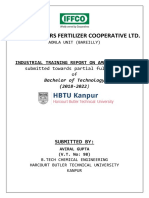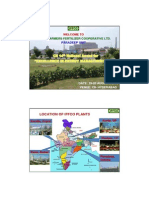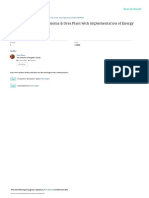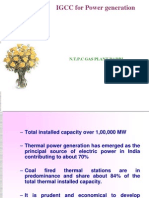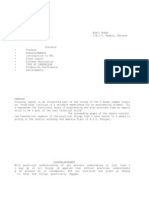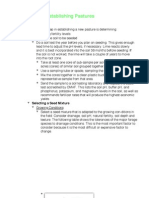UREA Data 1
UREA Data 1
Uploaded by
simaproindia4958Copyright:
Available Formats
UREA Data 1
UREA Data 1
Uploaded by
simaproindia4958Original Description:
Copyright
Available Formats
Share this document
Did you find this document useful?
Is this content inappropriate?
Copyright:
Available Formats
UREA Data 1
UREA Data 1
Uploaded by
simaproindia4958Copyright:
Available Formats
Brief Summary for Energy Saving Project of IFFCO, Kalol
1.0 EXECUTIVE SUMMARY
Indian Farmers Fertiliser Co-operative Limited (IFFCO) is a national level cooperative
society engaged in the manufacture and marketing of various fertilizers including the
training to the farmers for skill development related to agro-based requirement through
the country. The Society, registered as an autonomous cooperative under the Multi State
Cooperative Societies Act, 2002, was born out of the Indian farming community’s
initiative along with the Government of India on 3rd November, 1967.
IFFCO Kalol Unit (An ISO 9001 & 14001 certified Co-operative Society was
commissioned in 1974-75. Initially IFFCO Kalol Unit was designed for production of a
910 MTPD gas-based Ammonia Plant and 1200 MTPD Urea Plant. In 1997, capacities
of both Ammonia and Urea Plants were enhanced to 1100 MTPD and 1650 MTPD
respectively, for a total investment of Rs.150 crores, utilizing largely the available design
margins in the original equipment with minor additions / modifications in the Plant. A
naphtha Pre-reformer was installed as an add-on unit in Ammonia Plant to provide
flexibility to use naphtha as mixed-feed along with gas, keeping in view the constraints in
supply of natural gas from the Mehsana gas fields.
Naphtha pre-reformer unit of IFFCO Kalol is not in line since April 2009. The Ministry of
Chemical & Fertilisers, Department of fertilizer (DOF), Government of India vide
notification No 12012/3//2006-FPP dated 8th March 2007 asked all the naphtha and
LSHS/FO based fertilizer units to get converted to NG/LNG within a period of 3 years.
Now, Kalol Unit is in operation with 100% RNLG. Presently, Kalol Unit produces Urea at
the rate of 1780 Metric Tons per day (MTPD) capacity and Ammonia (Intermediate
Product) at the rate of 1140 MTPD to meet the annual target. As per Consent to Operate
issued by GSPCB, IFFCO Kalol Unit has been allowed to produce 6,02,000 MT of urea
per annum.
IFFCO Kalol unit is committed to use the energy in the most efficient way. "Energy
Saving" is one of the major objectives of IFFCO. This has enabled to run the old vintage
Ammonia and Urea Plants with better performance level even after 40 years of
operation. IFFCO Kalol has been continuously improving its performance by
implementing several modifications and by adopting best operating philosophy under
scientifically based emerging technology. IFFCO Kalol Unit is reluctantlessly striving to
be prove itself as the lowest energy consumer in the fertilizer industry. To achieve its
Projects & Development India Limited, Sindri 1 of 8
Brief Summary of Energy Saving Project of IFFCO, Kalol
goal, a number of energy conservation schemes have been identified, planned and
implemented in stages under Energy Saving Projects (ESP).
Production of Ammonia is an energy intensive process. Ammonia production accounts
about 80-90% of total energy consumption in Ammonia-Urea Complex. Energy is a
major factor in the cost of Ammonia & Urea production and hence, there has always
been a big scope for energy conservation efforts in Ammonia – Urea Plants.
IFFCO proposes the energy saving project to implement the latest available proven
technological solution to meet the target of substantial reduction in energy consumption
at its Kalol Complex. With implementation of energy saving project, around 10%
increase in Ammonia and urea production has been envisaged.
IFFCO has engaged Projects & Development India Ltd (PDIL) as consultant for
preparation of Pre Feasibility Report. PDIL has prepared the PFR on the basis of site
visit and data / documents provided by IFFCO officials.
1.1 PROJECT LOCATION
IFFCO Kalol fertilizer complex is located near village Saij in Gandhinagar District of
Gujrat State. IFFCO Kalol Unit is spread over an area of about 96 Hectares of land.
Kalol Unit is located near the State Highway No. 41 (connecting Ahmedabad-Mehsana),
25 Kms North-east of Ahmedabad city and about 4 km from Kalol town. The nearest
railway station is Kalol, which is on Ahmedabad-Mehsana section and about 4 km north
from the site. Geographically the fertilizer complex is located at Longitude 23º 12’ 44” N
and Latitude 72º 31’ 22” E at an elevation of 60 to 65 m above mean sea level (MSL).
Location map has been presented in Plate-1 & 2.
1.2 SCOPE OF ENERGY SAVING PROJECT
The scope of Feasibility Study has been aimed at to reduce the Urea specific energy
consumption by about 0.221 Gcal per MT of Urea at Kalol Fertiliser Complex. To
achieve the target, the following energy saving schemes have been considered.
Projects & Development India Limited, Sindri 2 of 8
Brief Summary of Energy Saving Project of IFFCO, Kalol
1.2.1 Schemes to be Implemented in Kalol
Following schemes have been envisaged in ESP:
(A) Ammonia
Table-1.1
Schemes Considered for Ammonia Plant
Sr.No. Schemes under consideration
1. Installation of New single steam turbine for Synthesis gas Compressor
2. New air burner for Secondary Reformer
3. Installation of saturated coil at suction of ID fan.
4. Installation of Fuel gas Expander with preheaters and bypass arrangement
5. Hot desulphurization of feed gas in place of activated carbon
6. New additional MP Boiler in between Ammonia Converters
7. Ammonia Recovery from Synthesis Loop LP Purge Gases
8. Installation of MP Stripper for Process Condensate Stripping
9. Installation of New Methanator Feed/ Effluent Heat Exchanger
10. Installation of New Trim Heater at the exit of HTS (For Methanator
Temperature Control)
11. Installation of new BFW Pre Heater at exit of HTS (in place of existing
104C)
12. Replacement of Ammonia Converter BFW Pre Heater 123C
13. Saturated MP Steam Export from Synthesis Loop to Urea Plant
14. Reduction in Steam to Carbon Ratio from 3.3 to 3.0
(B) Urea
Table-1.2
Schemes Considered for Urea Plant
1. VAM for cooling of CO2 Compressor Suction Chilling
2. High Efficiency Trays in Urea Reactor
3. HP Split Flow Configuration Ejector and new HPCC
4. Replacement of Second Evaporator Heat Exchanger
5. Installation of HP Ammonia Pre Heater
Projects & Development India Limited, Sindri 3 of 8
Brief Summary of Energy Saving Project of IFFCO, Kalol
1.2.2 Scope of Work of Engineering Consultant
M/s CASALE would prepare basic engineering design package (BEDP) for the proposed
project as under:
(i) Design basis
(ii) Material balance, cooling water and steam & condensate balance
(iii) Process flow diagram for all section of the plants. The PFD shall be prepared
for design condition
(iv) Equipment list of new and modified equipments
(v) Engineering Process Specifications and data sheet for new and modified
equipments
(vi) Details of Tie-in points for taking tapping in plant turn-around marked on PIDs
(vii) Engineering specification for piping with reference to existing piping
specifications
(viii) Preliminary equipment arrangement for new and modified equipments
(ix) Electrical motors specification with emergency power requirement for new
and modified equipments
(x) First edition of P&I diagrams for all new and modified sections of the plants
The P&I diagrams shall show nominal diameters and medium symbols, walls
and instrumentation, i.e., control loops and measuring points, control logic
and analyzers, etc. Details of changes and modifications to the safety inter-
lock trip systems for new and modified parts shall be shown in separate
diagrams.
(xi) Line list for new and modified piping based on existing pipings class
specifications.
(xii) Insulation requirement, if any.
(xiii) Slope requirements of lines, if any.
(xiv) Proposed modified plot plan showing the general layout for all new and
modified section of the plant
(xv) Marked up existing plot plan showing the available area for the new
equipments
(xvi) Layout of the equipments and space required.
Projects & Development India Limited, Sindri 4 of 8
Brief Summary of Energy Saving Project of IFFCO, Kalol
(xvii) Trip interlock logic diagram of new and modified sections showing trip set
points, alarm annunciation and set points & delay time and manual reset.
(xviii) Data sheet for new and modified control valves and new safety valves
(xix) Typical Hook-up drawing for new and modified instruments loops
(xx) Functional instrument diagrams and loop diagrams for documenting very
complicated loops
(xxi) HAZOP study for new installations and modifications
(xxii) Operating Manual / guidelines for the new installations and their integration in
existing plants, highlighting normal operations, start-up and shut-down
operations which are modified after revamping.
1.3 RAW MATERIAL AND UTILITIES
Basic purpose of implementation of energy saving schemes at each unit is to conserve
the raw materials i.e. natural gas and water. There will be over all saving of natural gas
of 13360 Sm3/day and 200 m3/day water in Kalol Unit. No additional raw materials will be
required for the proposed project.
1.4 PROJECT IMPLEMENTATION PLAN & TIME SCHEDULE
The ESP will be implemented in two Phases. Energy savings schemes which required
short lead time will be implemented during year 2016 turnaround and energy savings
schemes which required long lead time will be implemented during year 2017
turnaround.
1.5 ESTIMATED PROJECT CAPITAL COST
The estimated capital cost of ESP is as under (Rs. Crore):
Table-1.4
Estimated Cost
Sr No Units Equipment Cost BEDP DEDP Total
(including 3%
Contingency)
1. Kalol 192 17 4 213
2. TOTAL 192 17 4 213
BEDP : Basic Engineering Design Package
DEDP : Detailed Engineering Design Package
Projects & Development India Limited, Sindri 5 of 8
Brief Summary of Energy Saving Project of IFFCO, Kalol
1.6 FINANCIAL ANALYSIS OF PROJECT
The overall saving in Urea specific energy at each Unit and the financial analysis will be
as under:
Table-1.5
Financial Analysis
ESP UNIT Kalol
Urea Production MTPD 1780
Total Energy Saving Gcal 393
Energy Saving Gcal/MT 0.221
Estimated Investment Rs. Crore 213
Energy Cost Rs./Gcal 2900
Monetary Savings /Year Rs Crore 42
Payback Years 5.1
1.6 SAVINGS OF RAW MATERIAL OF PROJECT
The present raw material consumption is as under:
Table-1.6
Raw Material Consumption
Particulars Unit Kalol
Urea Production MTPD 1780
Total gas consumption SM3/day 1190901
Feed gas in Ammonia SM3/day 684461
Fuel gas in Ammonia SM3/day 373997
Fuel to Steam generation SM3/day 132443
Power (imported from State grid) MWH/day 159.8
Urea Energy Gcal/MT 5.573
Savings of raw material after ESP is as under:
Projects & Development India Limited, Sindri 6 of 8
Brief Summary of Energy Saving Project of IFFCO, Kalol
Table-1.7
Savings on Raw Material
Particulars Unit Raw Material Consumption
Existing Proposed Saving
Total NG SM3/day 1190901 1177541 13360
Water m3/day 14,000 13800 200
1.7 NEED & JUSTIFICATION
The need and justification of the proposed project is summarized as under:
¾ It will reduce overall energy consumption leading to a substantial reduction
in pollution load.
¾ It will decrease the dependency of IFFCO, Kalol unit over GSEB grid
¾ It will reduce the consumption of natural resources viz. water (approx.
200 m3/d) & NG (13360 Sm3/day) ) which in turn will have positive
impact on environment
¾ It will impose positive impact on the consumption pattern of electricity in
near-by area
¾ It will reduce the subsidy burden of Government of India (GOI).
¾ It will maintain the profitability of IFFCO.
¾ It will maintain stability in indigenous / domestic market for Urea.
¾ It will check the import possibility of fertilizers to some extent and yield
national savings
¾ There will be temporary employment generation during construction period.
¾ It will ease the availability of chemical fertilizers to farmers.
¾ Adoption of proven long lasting emerging technology will produce the
intangible effect to reduce the present stress of environment.
¾ It will fulfill the aims and objective of EIA related to continual improvement in
the field of Energy Saving by adopting emerging technology.
¾ The reduction of green house gas emissions from the stack will contribute to
INTENDED NATIONALLY DETERMINED CONTRIBUTION (INDC) under
UNEPCCC.
¾ ESP is a complement to “India’s Low Carbon Strategy” to meet the target
of carbon reduction equivalent to 20-25% of GDP by 2020 against the base
of 2005.
Projects & Development India Limited, Sindri 7 of 8
Brief Summary of Energy Saving Project of IFFCO, Kalol
1.8 Conclusion
As energy cost is increasing with passage of time, it is prudent to take the measures to
save the energy at each location of IFFCO Plants. It is always the endeavour of
IFFCO’s top management to adopt the latest available and proven technology for
improving the productivity of the Society. With the efforts taken by IFFCO management
in the past, the IFFCO Plants are running at comparable energy consumption with
global benchmarks. The proposed Energy Saving Project (ESP) will further reduce the
energy consumption at all the nitrogenous fertiliser units. With implementation of the
proposed Energy Saving Project (ESP), the overall urea specific energy will be
reduced by about 0.221 Gcal per MT of Urea with payback of 5.1 Years. Thus, there
will be reduction in the emission levels with implementation of Energy saving project
due to reduction in consumption of natural gas, imported power and water.
The ESP is simply a change-over scheme without any change in production rate. For
this type of project, EIA Notification 2006 is also silent on preparation of EIA report and
issuance of EC. Further, it would not be out of place to mention here that the area
around IFFCO Kalol Unit has never been identified as “CRITICALLY POLLUTED
AREA / ZONE” by CPCB. Further, the ESP fulfills the IFFCO policy related to
protection & safe guard of environment and measures for energy conservation. It also
fulfills the aims & objective of EIA.
Considering the above facts, it requires a critical review with due diligence regarding
exemption of Public Hearing and preparation of EIA report in generic form for grant of
EC on priority basis.
Projects & Development India Limited, Sindri 8 of 8
You might also like
- Athenaze IT With English GlossDocument224 pagesAthenaze IT With English GlossВиталий Бережной100% (1)
- Gail Usar DFRDocument15 pagesGail Usar DFRAbhijeet kohatNo ratings yet
- Can Humins Live On Planet RizqDocument8 pagesCan Humins Live On Planet Rizqkbarn389100% (3)
- PowerPoint PresentationDocument6 pagesPowerPoint PresentationBibinNo ratings yet
- Experiment 7: Acids, Bases and SaltsDocument30 pagesExperiment 7: Acids, Bases and Saltstwinkledreampoppies50% (6)
- Pre Feasibilityreport (PFR) FileDocument39 pagesPre Feasibilityreport (PFR) FilesivsyadavNo ratings yet
- 0 0 23 Jul 2015 1758524971Annexure-Pre-feasibilityReport (PFR) FileDocument47 pages0 0 23 Jul 2015 1758524971Annexure-Pre-feasibilityReport (PFR) Filehina patelNo ratings yet
- 11062015XL38J3Q0Annexure documentofEIADocument368 pages11062015XL38J3Q0Annexure documentofEIAeastNo ratings yet
- Ammonia and Urea Plants PDFDocument48 pagesAmmonia and Urea Plants PDFbenon100% (1)
- Brief Desccription of Ammonia Urea Plants With RevampDocument48 pagesBrief Desccription of Ammonia Urea Plants With RevampGeorge Van BommelNo ratings yet
- Indian Farmers Fertilizer Cooperative LTD.: Industrial Training Report On Ammonia PlantDocument47 pagesIndian Farmers Fertilizer Cooperative LTD.: Industrial Training Report On Ammonia PlantJin PingNo ratings yet
- Energy EfficiencyDocument15 pagesEnergy EfficiencyKhumar TaghizadaNo ratings yet
- Hydrogen Production Via Cpv/soec Electrolysis Integrated As Stage I Reactor in The Haber-Bosch Ammonia SynthesisDocument7 pagesHydrogen Production Via Cpv/soec Electrolysis Integrated As Stage I Reactor in The Haber-Bosch Ammonia SynthesisKabolobari BenakoleNo ratings yet
- Iffco Phulpur ProjectDocument27 pagesIffco Phulpur ProjectRajeshkumar ElangoNo ratings yet
- 11 IffcoDocument26 pages11 IffcoVivek VishalNo ratings yet
- Clean Development Mechanism Project Design Document Form (CDM-SSC-PDD) Version 03 - in Effect As Of: 22 December 2006 IDocument26 pagesClean Development Mechanism Project Design Document Form (CDM-SSC-PDD) Version 03 - in Effect As Of: 22 December 2006 ImurugaraajNo ratings yet
- Hindustan Petroleum Corporation2016Document18 pagesHindustan Petroleum Corporation2016Ngô Mạnh CườngNo ratings yet
- Information Required For ESIA - Gie - 2018!01!18Document11 pagesInformation Required For ESIA - Gie - 2018!01!18hassan zakwanNo ratings yet
- 13 - PPSS Plant Design For Waste-To-Energy Ash Valorization 2023 v1Document7 pages13 - PPSS Plant Design For Waste-To-Energy Ash Valorization 2023 v1yohannearachchi2001No ratings yet
- Exe Sum Apolo EngDocument29 pagesExe Sum Apolo EngvengielNo ratings yet
- Ammonia Plant Brief DescriptionDocument44 pagesAmmonia Plant Brief Descriptionmohamed badranNo ratings yet
- General 317 IFFCO Aonla - 1 0 PDFDocument36 pagesGeneral 317 IFFCO Aonla - 1 0 PDFSuresh Kumar100% (1)
- M G Power, Nalgonda Dist. EXE SUM ENGDocument10 pagesM G Power, Nalgonda Dist. EXE SUM ENGlevelhead28No ratings yet
- 5A4. Oxy-Fuel Combustion (Oxygen-Firing of Conventional PCF System)Document2 pages5A4. Oxy-Fuel Combustion (Oxygen-Firing of Conventional PCF System)tiu4tonNo ratings yet
- 12 Integrated SteelDocument16 pages12 Integrated SteelKushagra JadhavNo ratings yet
- Adani Power Limited CS NECA2012 First PrizeDocument6 pagesAdani Power Limited CS NECA2012 First Prizechandan mishraNo ratings yet
- EIL - EIA Study - Refinery Unit DesalinationDocument24 pagesEIL - EIA Study - Refinery Unit DesalinationSwapnil WankhedeNo ratings yet
- PDD Iffco SFC KotaDocument84 pagesPDD Iffco SFC KotaRajeshkumar ElangoNo ratings yet
- Atul LimitedDocument7 pagesAtul LimitedHardik PatelNo ratings yet
- Paper Id249 Powergen2012Document21 pagesPaper Id249 Powergen2012arunNo ratings yet
- Sasan Power Plant GHG StudyDocument15 pagesSasan Power Plant GHG StudyNur 'Atenk' DwiyantoNo ratings yet
- IGCC For Power Generation: N.T.P.C Gas Plant DadriDocument25 pagesIGCC For Power Generation: N.T.P.C Gas Plant DadriAmit JhaNo ratings yet
- 12Document29 pages12Enrique CastañedaNo ratings yet
- Executive Summary Power PlantDocument10 pagesExecutive Summary Power PlantBISMI1No ratings yet
- Design Project Description 2013Document10 pagesDesign Project Description 2013Eunice MayhoongNo ratings yet
- 27 Mar 2017 174459307QY7CPBYEAnnexure-Pre-feasibilityReport (PFR) FileDocument57 pages27 Mar 2017 174459307QY7CPBYEAnnexure-Pre-feasibilityReport (PFR) Filebhavesh vasavaNo ratings yet
- CDR UnitDocument17 pagesCDR UnitsatishchemengNo ratings yet
- Ami ProDocument15 pagesAmi Proamits3481No ratings yet
- Fluidized Bed Technologies For High Ash Indian Coals - A Techno-Economic EvaluationDocument28 pagesFluidized Bed Technologies For High Ash Indian Coals - A Techno-Economic EvaluationRudra Banerjee100% (1)
- Reliance Industries Limited, Hazira Manufacturing Division (HMD) Hazira, GujaratDocument21 pagesReliance Industries Limited, Hazira Manufacturing Division (HMD) Hazira, GujaratJatin SharmaNo ratings yet
- GSFC Energy EfficiencyDocument28 pagesGSFC Energy EfficiencyRajeshkumar ElangoNo ratings yet
- IFFCODocument12 pagesIFFCOshank100No ratings yet
- IFFCO AonlaDocument14 pagesIFFCO AonlaNirmal KumarNo ratings yet
- Latest Developments in Ammonia Production TechnologyDocument21 pagesLatest Developments in Ammonia Production TechnologyAnonymous msVFza100% (4)
- UntitledDocument22 pagesUntitledsinghalmayank950No ratings yet
- IFFCO Kalol Energy SavingDocument24 pagesIFFCO Kalol Energy SavingRajeshkumar ElangoNo ratings yet
- Chevron Richmond Refinery Revised Renewal Project - Conditional Use Permit/Amended EIR ApplicationDocument20 pagesChevron Richmond Refinery Revised Renewal Project - Conditional Use Permit/Amended EIR ApplicationCVX_Richmond_RenewalNo ratings yet
- Abu Quir Iii Start Up PDFDocument18 pagesAbu Quir Iii Start Up PDFAnonymous 1XHScfCI100% (1)
- BPCL Executive Summary EnglishDocument5 pagesBPCL Executive Summary EnglishRavikant KumarNo ratings yet
- Jindal Steel and Power Limited: First Prize Integrated Steel PlantsDocument11 pagesJindal Steel and Power Limited: First Prize Integrated Steel PlantsPrasenjit DeyNo ratings yet
- An Experimental Investigation Into The Use of Molten Carbonate Fuel Cells To Capture Co2 From Gas Turbine Exhaust GasesDocument8 pagesAn Experimental Investigation Into The Use of Molten Carbonate Fuel Cells To Capture Co2 From Gas Turbine Exhaust GasesRitesh AgarwalNo ratings yet
- Oin Ops Chem 014 Recommendations of Epri WorkshopDocument15 pagesOin Ops Chem 014 Recommendations of Epri WorkshopraniNo ratings yet
- Optimisation_of_Air_Source_Heat_Pumps_inDocument10 pagesOptimisation_of_Air_Source_Heat_Pumps_inchopinaNo ratings yet
- Articles 04Document16 pagesArticles 04Poliana PolyNo ratings yet
- Other Plant Feasibility Report PDFDocument36 pagesOther Plant Feasibility Report PDFsvvsnrajuNo ratings yet
- Energy R&D Bhel Role & ContributionDocument24 pagesEnergy R&D Bhel Role & ContributionAshok KumarNo ratings yet
- Fadhili Gip Envid Report: Offshore Gas Increment ProgramDocument66 pagesFadhili Gip Envid Report: Offshore Gas Increment Programmohamed esmailNo ratings yet
- 07032018E9Y4LNL8FinalwithAnnexureDocument47 pages07032018E9Y4LNL8FinalwithAnnexuressingh.lnteccNo ratings yet
- 4000 MTPD Ammonia Plant PaperDocument8 pages4000 MTPD Ammonia Plant PaperJose DenizNo ratings yet
- BR 1844 Babcock MercuryDocument10 pagesBR 1844 Babcock MercuryblairalblairalNo ratings yet
- Background:: Project Location: Aditya Aluminium Is Located in Sambalpur District of Odisha State. TheDocument10 pagesBackground:: Project Location: Aditya Aluminium Is Located in Sambalpur District of Odisha State. TheNitanshu ChavdaNo ratings yet
- Assement of Bag Filter Vs ESP CPCBDocument133 pagesAssement of Bag Filter Vs ESP CPCBdehriya100% (1)
- Synthetic Natural Gas: From Coal, Dry Biomass, and Power-to-Gas ApplicationsFrom EverandSynthetic Natural Gas: From Coal, Dry Biomass, and Power-to-Gas ApplicationsTilman J. SchildhauerNo ratings yet
- Global hydrogen trade to meet the 1.5°C climate goal: Part II – Technology review of hydrogen carriersFrom EverandGlobal hydrogen trade to meet the 1.5°C climate goal: Part II – Technology review of hydrogen carriersNo ratings yet
- Haier MRV S Outdoor Installation ManualDocument28 pagesHaier MRV S Outdoor Installation ManualEduardo Andrés Romo ToledoNo ratings yet
- Cre Una PDFDocument164 pagesCre Una PDFChetana PatilNo ratings yet
- Idea Proposal Format E-Yantra Innovation Challenge 2020-21: Project NameDocument5 pagesIdea Proposal Format E-Yantra Innovation Challenge 2020-21: Project NameNishant MishraNo ratings yet
- Management of Traumatic HyphemaDocument38 pagesManagement of Traumatic HyphemaKaisun TeoNo ratings yet
- Pain Community Centre - Who Analgesic Ladder - 2011-03-15Document3 pagesPain Community Centre - Who Analgesic Ladder - 2011-03-15Karina WibowoNo ratings yet
- Case Analysis On Therapeutic Community Modality Program at Mountain Province DistrictDocument4 pagesCase Analysis On Therapeutic Community Modality Program at Mountain Province DistrictChristopher PerazNo ratings yet
- Knights of Columbus ACTION PLAN CY 2020 - 2021: Lepanto Council No. 8127Document3 pagesKnights of Columbus ACTION PLAN CY 2020 - 2021: Lepanto Council No. 8127Adrian VenturaNo ratings yet
- Qa/Qc Department: ICOM QC Inspector Client QC Inspector Name Signature DateDocument2 pagesQa/Qc Department: ICOM QC Inspector Client QC Inspector Name Signature Dategopi krishnaNo ratings yet
- Stockholder's EquityDocument8 pagesStockholder's EquityKaila stinerNo ratings yet
- Audience Effects - What Can They Tell Us About Social Neuroscience, Theory of Mind and Autism - PMCDocument18 pagesAudience Effects - What Can They Tell Us About Social Neuroscience, Theory of Mind and Autism - PMCanarcheistNo ratings yet
- Job Description Example: Farm Manager: Areas of ResponsibilityDocument4 pagesJob Description Example: Farm Manager: Areas of ResponsibilityTuong VuongNo ratings yet
- Screw Conveyore Feeders and Mixers CONTENTDocument17 pagesScrew Conveyore Feeders and Mixers CONTENTJoao BatistaNo ratings yet
- Lesson Plan On SchizophreniaDocument16 pagesLesson Plan On SchizophreniaKRISHAN BHARTINo ratings yet
- Are We Trading Our Happiness For Modern ComfortsDocument7 pagesAre We Trading Our Happiness For Modern ComfortsJohnNo ratings yet
- B01 MDJDVDocument16 pagesB01 MDJDVInn Dye ToryoNo ratings yet
- 5 - 2 2017 - Narrative InquiryDocument5 pages5 - 2 2017 - Narrative InquirySHAKILA ZAZA BINTI KAMUNI MoeNo ratings yet
- List of ElectropathyBooksDocument2 pagesList of ElectropathyBooksUmesh KumarNo ratings yet
- SelectionListR3Web21122020 PDFDocument701 pagesSelectionListR3Web21122020 PDFKhan Mohd SaalimNo ratings yet
- 〈63〉 Mycoplasma TestsDocument6 pages〈63〉 Mycoplasma TestsAvijit HazraNo ratings yet
- Shihlin SA3 Series User ManualDocument423 pagesShihlin SA3 Series User Manualhoangchien968No ratings yet
- FCU CaryaireDocument16 pagesFCU CaryaireTamaghna_Sinha_5273No ratings yet
- Muldner Et Richards 2005 JAS-dietDocument10 pagesMuldner Et Richards 2005 JAS-dietSlečna LahvováNo ratings yet
- Science 9 ModuleDocument14 pagesScience 9 ModuleJunriel Arig BonachitaNo ratings yet
- Pasture Production Publication #19 - Establishing PasturesDocument6 pagesPasture Production Publication #19 - Establishing PasturesSavannah Simone PetrachenkoNo ratings yet
- Research Article of Equilibrium Constant in Esterification ReactionDocument4 pagesResearch Article of Equilibrium Constant in Esterification ReactionViha Ancillia25% (4)
- Ballast Water Management Plan Appendix 4Document2 pagesBallast Water Management Plan Appendix 4Dāvis Dzērve100% (1)










